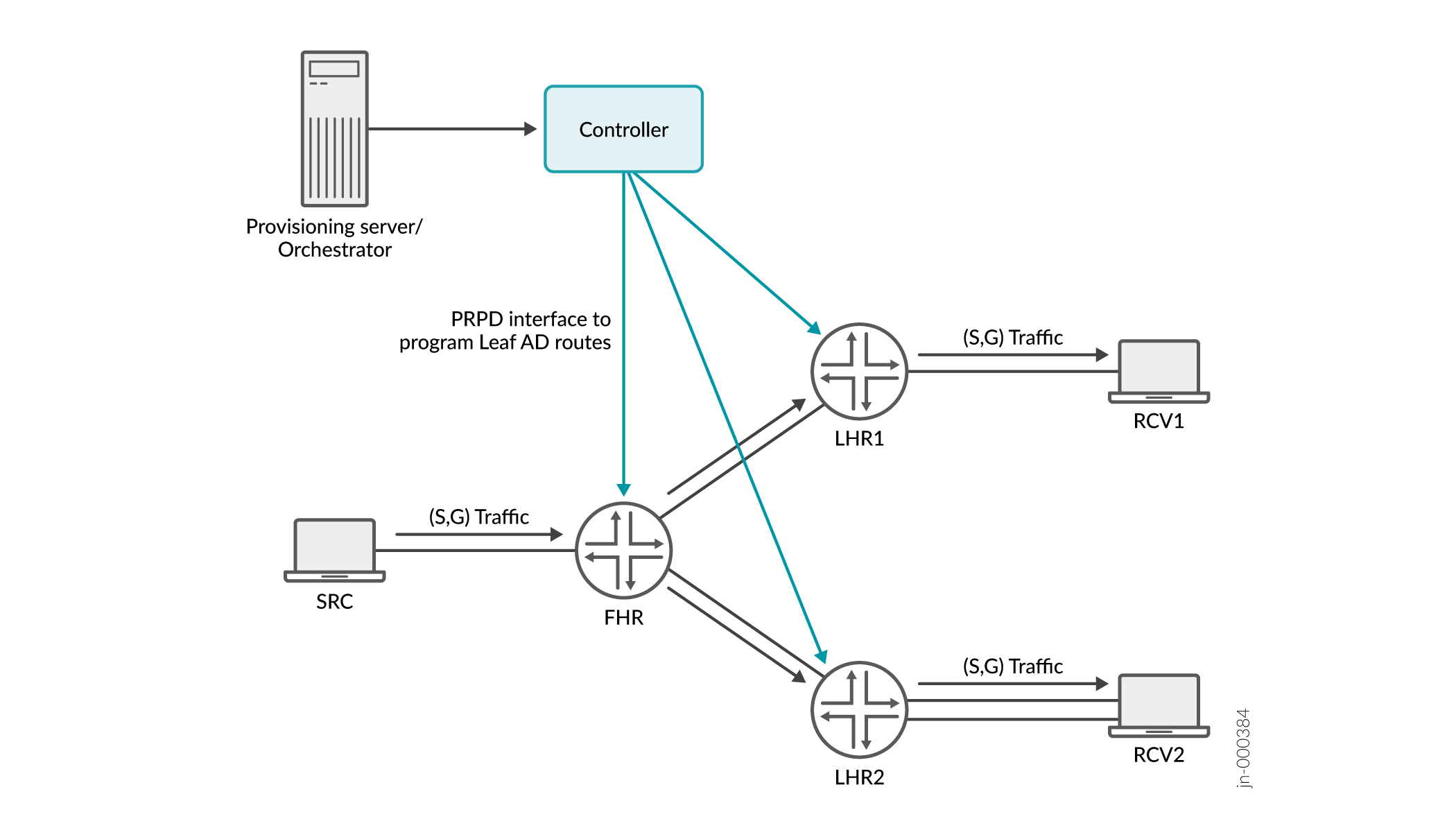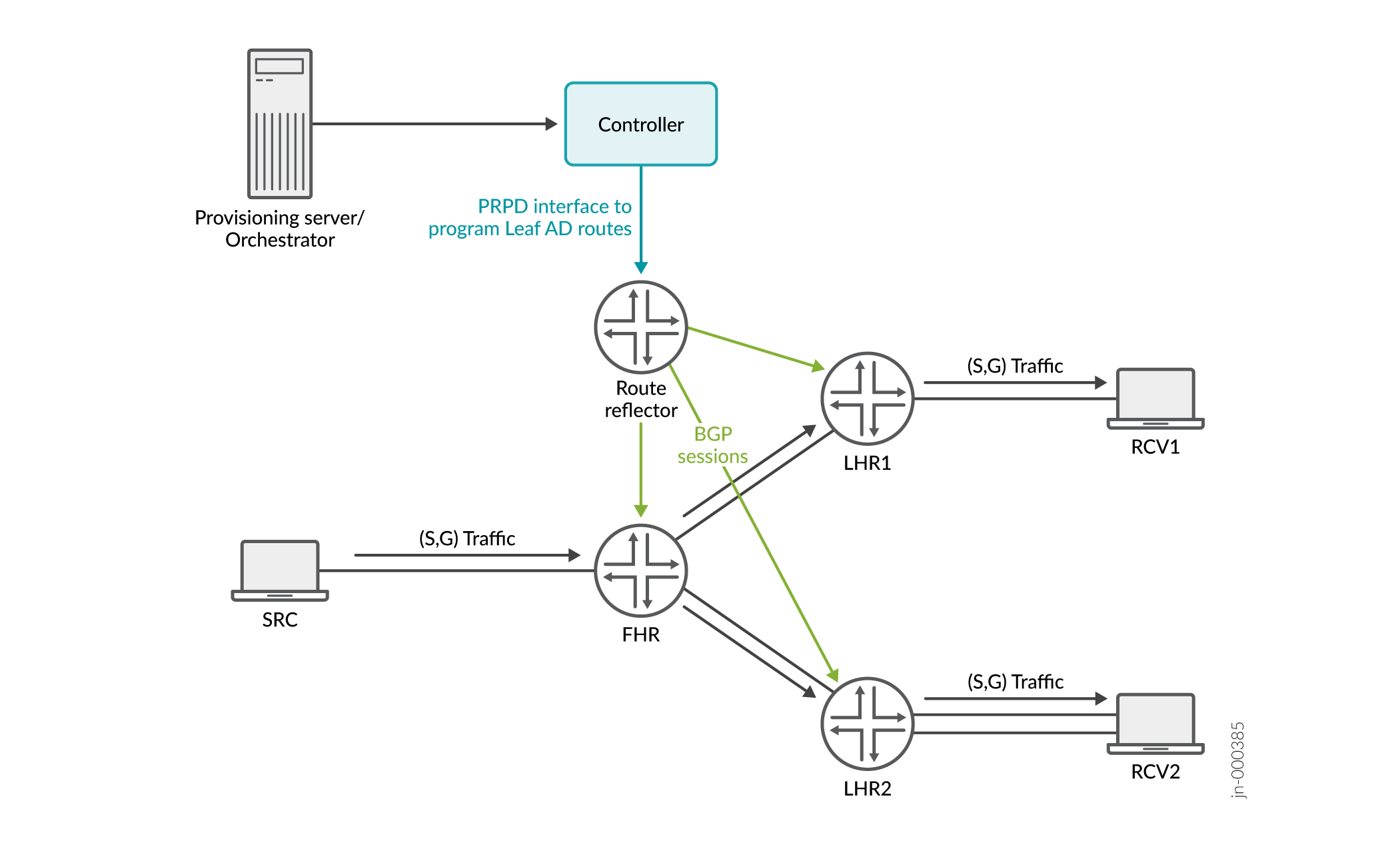- play_arrow Overview
- play_arrow Managing Group Membership
- play_arrow Configuring IGMP and MLD
- play_arrow Configuring IGMP Snooping
- IGMP Snooping Overview
- Overview of Multicast Forwarding with IGMP Snooping or MLD Snooping in an EVPN-VXLAN Environment
- Configuring IGMP Snooping on Switches
- Example: Configuring IGMP Snooping on Switches
- Example: Configuring IGMP Snooping on EX Series Switches
- Verifying IGMP Snooping on EX Series Switches
- Changing the IGMP Snooping Group Timeout Value on Switches
- Monitoring IGMP Snooping
- Example: Configuring IGMP Snooping
- Example: Configuring IGMP Snooping on SRX Series Devices
- Configuring Point-to-Multipoint LSP with IGMP Snooping
- play_arrow Configuring MLD Snooping
- Understanding MLD Snooping
- Configuring MLD Snooping on an EX Series Switch VLAN (CLI Procedure)
- Configuring MLD Snooping on a Switch VLAN with ELS Support (CLI Procedure)
- Example: Configuring MLD Snooping on EX Series Switches
- Example: Configuring MLD Snooping on SRX Series Devices
- Configuring MLD Snooping Tracing Operations on EX Series Switches (CLI Procedure)
- Configuring MLD Snooping Tracing Operations on EX Series Switch VLANs (CLI Procedure)
- Example: Configuring MLD Snooping on EX Series Switches
- Example: Configuring MLD Snooping on Switches with ELS Support
- Verifying MLD Snooping on EX Series Switches (CLI Procedure)
- Verifying MLD Snooping on Switches
- play_arrow Configuring Multicast VLAN Registration
-
- play_arrow Configuring Protocol Independent Multicast
- play_arrow Understanding PIM
- play_arrow Configuring PIM Basics
- Configuring Different PIM Modes
- Configuring Multiple Instances of PIM
- Changing the PIM Version
- Optimizing the Number of Multicast Flows on QFabric Systems
- Modifying the PIM Hello Interval
- Preserving Multicast Performance by Disabling Response to the ping Utility
- Configuring PIM Trace Options
- Configuring BFD for PIM
- Configuring BFD Authentication for PIM
- play_arrow Routing Content to Densely Clustered Receivers with PIM Dense Mode
- play_arrow Routing Content to Larger, Sparser Groups with PIM Sparse Mode
- Understanding PIM Sparse Mode
- Examples: Configuring PIM Sparse Mode
- Configuring Static RP
- Example: Configuring Anycast RP
- Configuring PIM Bootstrap Router
- Understanding PIM Auto-RP
- Configuring All PIM Anycast Non-RP Routers
- Configuring a PIM Anycast RP Router with MSDP
- Configuring Embedded RP
- Configuring PIM Filtering
- Examples: Configuring PIM RPT and SPT Cutover
- Disabling PIM
- play_arrow Configuring Designated Routers
- play_arrow Receiving Content Directly from the Source with SSM
- Understanding PIM Source-Specific Mode
- Example: Configuring Source-Specific Multicast
- Example: Configuring PIM SSM on a Network
- Example: Configuring an SSM-Only Domain
- Example: Configuring SSM Mapping
- Example: Configuring Source-Specific Multicast Groups with Any-Source Override
- Example: Configuring SSM Maps for Different Groups to Different Sources
- play_arrow Minimizing Routing State Information with Bidirectional PIM
- play_arrow Rapidly Detecting Communication Failures with PIM and the BFD Protocol
- play_arrow Configuring PIM Options
- play_arrow Verifying PIM Configurations
-
- play_arrow Configuring Multicast Routing Protocols
- play_arrow Connecting Routing Domains Using MSDP
- play_arrow Handling Session Announcements with SAP and SDP
- play_arrow Facilitating Multicast Delivery Across Unicast-Only Networks with AMT
- play_arrow Routing Content to Densely Clustered Receivers with DVMRP
-
- play_arrow Configuring Multicast VPNs
- play_arrow Configuring Draft-Rosen Multicast VPNs
- Draft-Rosen Multicast VPNs Overview
- Example: Configuring Any-Source Draft-Rosen 6 Multicast VPNs
- Example: Configuring a Specific Tunnel for IPv4 Multicast VPN Traffic (Using Draft-Rosen MVPNs)
- Example: Configuring Source-Specific Draft-Rosen 7 Multicast VPNs
- Understanding Data MDTs
- Example: Configuring Data MDTs and Provider Tunnels Operating in Any-Source Multicast Mode
- Example: Configuring Data MDTs and Provider Tunnels Operating in Source-Specific Multicast Mode
- Examples: Configuring Data MDTs
- play_arrow Configuring Next-Generation Multicast VPNs
- Understanding Next-Generation MVPN Network Topology
- Understanding Next-Generation MVPN Concepts and Terminology
- Understanding Next-Generation MVPN Control Plane
- Next-Generation MVPN Data Plane Overview
- Enabling Next-Generation MVPN Services
- Generating Next-Generation MVPN VRF Import and Export Policies Overview
- Multiprotocol BGP MVPNs Overview
- Configuring Multiprotocol BGP Multicast VPNs
- BGP-MVPN Inter-AS Option B Overview
- ACX Support for BGP MVPN
- Example: Configuring MBGP MVPN Extranets
- Understanding Redundant Virtual Tunnel Interfaces in MBGP MVPNs
- Example: Configuring Redundant Virtual Tunnel Interfaces in MBGP MVPNs
- Understanding Sender-Based RPF in a BGP MVPN with RSVP-TE Point-to-Multipoint Provider Tunnels
- Example: Configuring Sender-Based RPF in a BGP MVPN with RSVP-TE Point-to-Multipoint Provider Tunnels
- Example: Configuring Sender-Based RPF in a BGP MVPN with MLDP Point-to-Multipoint Provider Tunnels
- Configuring MBGP MVPN Wildcards
- Distributing C-Multicast Routes Overview
- Exchanging C-Multicast Routes
- Generating Source AS and Route Target Import Communities Overview
- Originating Type 1 Intra-AS Autodiscovery Routes Overview
- Signaling Provider Tunnels and Data Plane Setup
- Anti-spoofing support for MPLS labels in BGP/MPLS IP VPNs (Inter-AS Option B)
- BGP-MVPN SD-WAN Overlay
- play_arrow Configuring PIM Join Load Balancing
- Use Case for PIM Join Load Balancing
- Configuring PIM Join Load Balancing
- PIM Join Load Balancing on Multipath MVPN Routes Overview
- Example: Configuring PIM Join Load Balancing on Draft-Rosen Multicast VPN
- Example: Configuring PIM Join Load Balancing on Next-Generation Multicast VPN
- Example: Configuring PIM Make-Before-Break Join Load Balancing
- Example: Configuring PIM State Limits
-
- play_arrow Troubleshooting
- play_arrow Knowledge Base
-
- play_arrow Configuration Statements and Operational Commands
Controller-Based BGP Multicast Signaling
Network controllers that are aware of the network topology and the events within the topology can calculate end-to-end explicit paths. This calculation results in optimum multicast trees between the source and the receivers. A network controller uses the programmable routing protocol daemon (PRPD) and BGP signaling to signal each router on the multicast tree to set up and program multicast forwarding states.
The controller uses PRPD APIs to program BGP multicast network layer reachability information (NLRI). All the routers are programmed either directly or through a route reflector. A route reflector also propagates the NLRI to all the routers on the trees. Based on the NLRI received, the routers set up appropriate forwarding states.
In the following sections of this topic we use controller to mean network controller.
Benefits of Controller-Based BGP Multicast Signaling
Traditional multicast deployments have inherent drawbacks. Controller-based BGP signaling eliminates drawbacks such as the following:
In hop-by-hop multicast protocols such as Protocol Independent Multicast (PIM), among other limitations, the any-source multicast mode needs periodic refreshing and is complex to configure. PIM source-specific multicast and PIM-Port mode have similar drawbacks.
Data centers that use BGP as their primary routing protocol avoid deploying multicast, because this deployment requires additional protocols and creates associated complexities.
Transit Router Programming Based on PRPD
With the help of a provisioning server or orchestrator, the controller is aware of the multicast flow information of the source, groups, and receivers. The controller calculates an optimum tree to forward the source traffic to all the interested receivers for a group.

After calculating the multicast tree, the controller uses the PRPD interface to program each transit router on the tree with the BGP multicast Leaf Auto Discovery (AD) NLRI. The Leaf AD route contains the source, group, and upstream information.
The Leaf AD NLRI also carries a tunnel encapsulation attribute (TEA) that has information about the downstream routers to which traffic needs to be replicated. TEA is a transitive BGP path attribute that specifies the encapsulation protocols and any additional information required to use those protocols correctly.
Using this information, a router can program the multicast forwarding states to forward traffic.
Route Reflector Programming Based on PRPD and Traffic Transmission Using BGP
At times, the controller may not have PRPD connections to all the transit routers. But if BGP is running on the network, the controller needs only a single PRPD connection to a route reflector or a virtual route reflector (vRR). Using the multicast information about the source, group, and receivers, the controller programs the BGP multicast NLRI intended for all the routers on the multicast tree on the route reflector. The route reflector further propagates the BGP multicast NLRI through BGP signaling to all its neighbors which eventually reaches all the routers on the multicast tree.

If the route target associated with the NLRI has the router ID of the intended router, the router accepts the route and an appropriate forwarding state is programmed on the router.
The route target resolution RIB by default is inet.3. For BGP multicast to work, you need to explicitly set the rib resolution to inet.0 in the configuration by using this command:
set routing-options resolution rib bgp.rtarget.0 resolution-ribs
inet.0
You can also apply route target constraints to filter the routes from the route reflector.





















